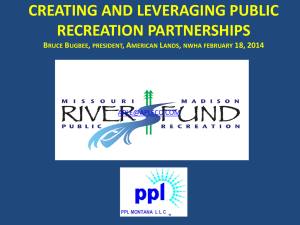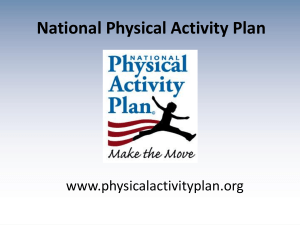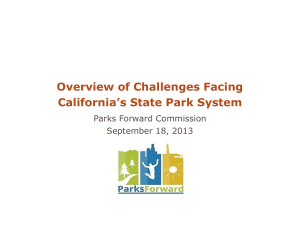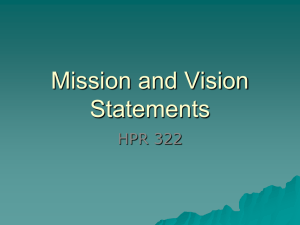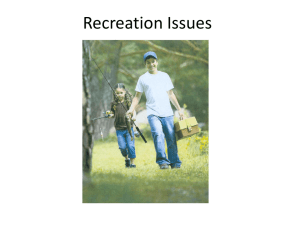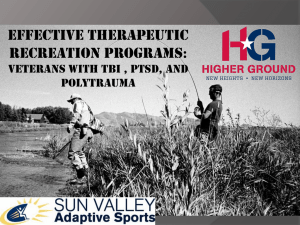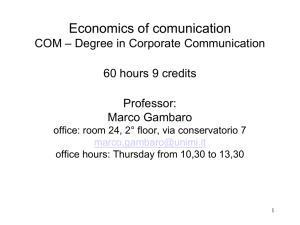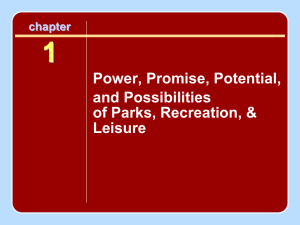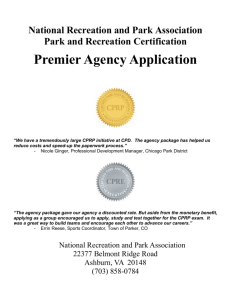NRPS CPRP EXAM Presentation - Nevada Recreation & Park Society
advertisement
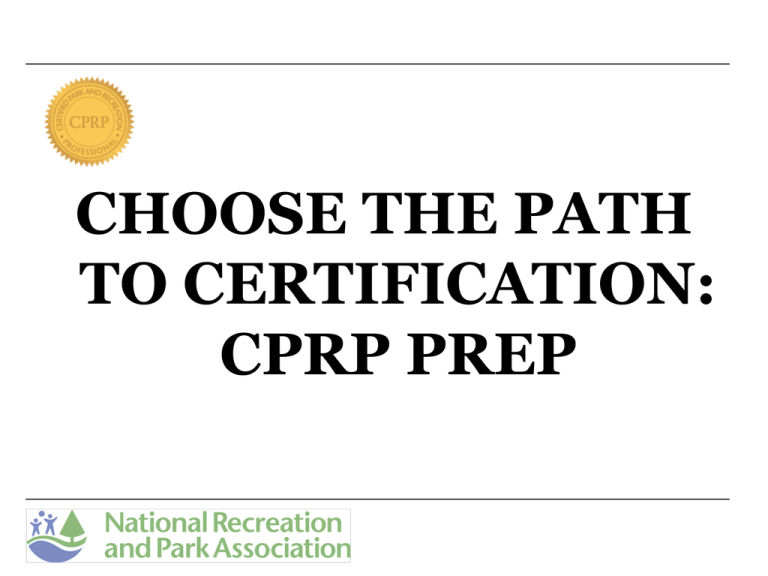
CHOOSE THE PATH TO CERTIFICATION: CPRP PREP Introductions Who are we – Dan McLean Professor University of Nevada, Las Vegas – Dirk Richwine CRPE, Recreation Superintendent Henderson, Professional Development Why become involved with State and National Associations – Networking opportunities/Building connections – Become part of the movement through advocacy – Jump start your career – Volunteer opportunities – Resource availability PARK AND RECREATION PROFESSIONAL CERTIFICATIONS Certified Park and Recreation Professional (CPRP) Certification for individuals in the field of parks and recreation Certification exam is offered to individuals that meet qualifications. Certification cycle is 2 years and maintained through achieving 2.0 Continuing Education Units (CEUs). Certified Park and Recreation Executive (CPRE) The CPRE establishes a national standard for managerial, administrative and executive parks and recreation professionals. Qualifications to sit for the CPRP Examination • have a current CPRP Certification and • have a Bachelors degree and 5 years of professional fulltime manager experience or have a Masters degree or higher and 4 years of professional full-time manager experience • Certification was established in 2011. The first CPRE examinations will be administered at the 2011 Congress in Atlanta, GA. History of the CPRP Certification • 1950’s - Park and Recreation Professional Registry • 1970’s - Certified Leisure Professional (CLP) Certification • 1991 - First CLP examination • 2000 - Certified Leisure Professional (CLP) transitioned to Certification Park and Recreation Professional (CPRP) • 2008 - Certification documents were centralized to NRPA • 2011 - CPRP Job Analysis • 2011 - CPRE Creation/Implementation CPRP Eligibility Requirements • Have just received, or are set to receive, a Bachelor’s degree from a program accredited by the Council on Accreditation(Students who have not yet graduated from an COA accredited program with a major in recreation, park resources, and leisure services but are in their final semester on campus may be able to qualify for exam status) • Have a Bachelor’s degree from any institution in recreation, park resources, or leisure services; and also have no less than 1 year of full-time experience in the field • Have a Bachelor’s degree in a major other than recreation, park resources, or leisure services; and also have no less than 3 years of full-time experience in the field • Have a high school degree or equivalent, and have 5 years of full-time experience in the field **1 year of part-time work experience in the field (20 hours+ per week) = 6 months of full-time work experience in the field Why CPRP Certification – Professional view Credibility Global Recognition Community Career Advantage Practical Skills Why CPRP Certification – Employer view Credibility Broad Perspective and Demonstrated Professionalism Highest Service, Education and Professional Excellence Effective & Efficient Professionals Competent Professionals + Higher Performance = Budget Efficiency Exam Summary • 3 Hour Allotted Time • 150 Questions (125 Scored, 25 Pre-test questions) • Computer-based test results are provided directly following examination • The examination content outline (core competencies) will assist you in preparation by providing number of questions 2011/12 Changes • Core Competencies – Current CBT (General Administration, Programming, and Operations Management) – CBT beginning March (Finance, Human Resources, Operations, and Programming) • Passing Score – Current (83 out of 125) – March (84 out of 125) Keep in Mind Questions are created from Park and Recreation Reference Books Questions are written from an Educators point of view Think national not regional Believe in yourself and your knowledge PRE-TEST OPERATIONS Customer Service • Systematic way of meeting the customer’s needs and responding to complaints and disputes. • Important for an organization internally and externally • You know good customer service when you see it Steps to Customer Service Follow up Handle the complaint Forward to appropriate person Acknowledge & inform person of the next step Receive without comment Emergency Response • Respond to Emergencies – First Aid/CPR – Accident/Incident Reports – Know emergency action plan • Follow the emergency action plan – Identify threats – Create an emergency operations plan – Develop an evacuation plan • Implement an emergency action plan – – – – Weather Plants and animals Societal threats Coordinate with local/state/federal officials • Provide input for a general security/safety plan - Regular safety inspections Americans with Disabilities Act (ADA) • Americans with Disabilities Act (ADA) • Enacted January 26, 1992 – Requires physical alterations to public accommodations undertaken after 1/26/92 to be readily accessible to & useable by people with disabilities to the maximum extent feasible – Any facilities built after 1/26/92 must be readily accessible for people with disabilities – Agencies that own, lease, lease out or operate*MUST* remove barriers Reasonable Accommodation • Americans with Disabilities Act • Disability – mental or physical impairment limits major life activity – CANNOT refuse participate because of the disability – Must make REASONABLE ACCOMMODATION – NO special charges – NOT excluded from services due to inaccessible facilities – Even if separate services operated, right to participate in regular services provided by the agency (inclusion) Work with Outside Groups • Benefits include efficiency & avoiding duplication of services • Require collaboration & communication • Written agreement that outlines: • Legal responsibilities/liabilities • Staff & program supervision details • Quality control • Partnership dissolution & review processes Network with Related Organizations • Other related Organizations • Districts/Departments • State Affiliates • Professional Associations • Professional Networking • Keep updated with current trends • Share resources • Find ways to work cooperatively to enhance services and improve efficiencies Provide Input for Capital Improvements Capital Budget: Separate from Operating Budget. Includes planned and proposed expenditures for long-term and substantial projects Capital Project: Project that is extremely costly. Facility Construction, Large Vehicles, Land Acquisition. Capital Budget Plans: 5-10 year plans are the norm Policies: Any purchase/project over $______ is to be considered a capital purchase or project. Provide Input for Capital Improvements Input from all levels of the organization is vital to creating a capital budget. • • • • • • Examples of Input for Capital Improvements from staff: Capital acquisitions for programs, facility or agency Develop areas and facilities Repair existing areas or facilities Replace equipment for safety purposes Enhance/expand recreation opportunities/services Improve the natural environment • Capital Improvement Proposals should: • Identify the benefits of the capital item • Projected life of the capital item • Possible sources of funding Maintain Information Systems Information Technology is: the means by which area personnel perform their information tasks . Org is comprised of many ops and admin functional areas – computers, registration systems, reservations systems……….. Umbrella term – covers a vast array of computer disciplines allowing orgs to manage their information resources. – Reshaping Organizations – investment in computing & communications to market, customer service, streamline ops, etc. Benefits: 1. 2. 3. 3. empowers people to do what they want to do. lets people be creative lets people be productive. lets people learn things Maintain Information Systems Basic Functions of Information Systems: 1. Input- collecting data 2. Communication – access/movement of data from one place to another 3. Processing – Transferring of data 4. Storage – keeping data for future use/reference 5. Retrieval – Recall of data when necessary 6. Output – transforming data into usable format 1980s – Terminals smaller and on desks. Electronic Data Entry – Park & Recreation professional can do own data entry – basic computer skills necessary. Maintain Information Systems Maintain Information Systems 1990s – PCs – immediate access to computer functions – Word processing – spreadsheets - email. • Little or no tech classes in R&P degree programs 2000s – Information Systems – one information resource (includes telephone) Records Management System is the lifeblood of an organization. Maintain Information Systems THREE MAJOR BIS Classifications for Parks & Recreation a. TRANSACTIONS SYSTEMS - Activity Registration, Facility Scheduling, Membership Systems b. WORK MANAGEMENT SYSTEMS – Work Orders, Work Requests, Inventories, Project Management, Maintenance Schedules. c. CASE MANAGEMENT SYSTEMS – Tracking of a specific participant or event. Administrative Systems Email, Financial, Personnel and Program Records, Property Inventories, Legal Documents, Accident Reports Maintain Information Systems Registration Program Registration locations should be physically accessible to all individuals. Types of Registration: Maintain Information Systems Registration Forms 1. Keep it simple 2. Obtain as much information as possible – why? Future Marketing What FORMS should include: Date * Contact Info * Programs Registering For * Program Fees * To whom check written* Liability Release * Payment method Info * Instructions where to send registration Maintain Information Systems Registration Process Data Entry Registration Procedures Staffing Registration Participant Supplies Cash Handling Maintain Information Systems How else do we Use/Maintain Information Systems today? Use permits Reservations Tracking Maintenance Memberships – Fitness – Aquatics Equipment use records Others Conduct Inventories Monitoring Contractors/Concessionaires RFP – framework for work/service to be done or provided WRITTEN POLICY- with parameters of hiring (reasons). SERVICE - written contractual agreements - defining the service to be provided, the expectations, length of service, financial arrangements, agency oversight and performance standards. MONITORING Concessionaires – Contractors – Contract Instructors • • • • Monthly Reporting – Revenue/Expense Reports- Issues-Attendance Inspections – Announced and Unannounced – Secret Shoppers Complaints – Review all End-user Satisfaction - Surveys SITE PLANS/MAPS Site Plan - A site plan is a top view, bird’s eye view of a property that is drawn to scale. A site plan can show: •Property lines •Outline of existing and proposed buildings and structures •Distance between buildings •Distance between buildings and property lines (setbacks) •Parking lots, indicating parking spaces •Driveways/trails •Utilities/Easements •Surrounding streets •Landscaped/Natural Areas – existing/proposed •Ground sign location •Ground Elevations SITE PLANS/MAPS Reading/Reviewing Site Plans – Maps 1. Legitimacy – does plan meet all requirements set forth by the agency? 2. Compliance – is the drawing accurate and consistent with any local zoning or code requirements? 3. Consistency – is the site plan consistent with the agency’s master plan? 4. Maps/Map Overlays Conduct Needs Assessments What is a needs assessment? Survey: provides accurate feedback on community attitudes, opinions, and perceptions of the park and recreation agency’s resources. • • • • • Programming Facilities Park Areas Products Services Direct Supervision Supervision of Specific Facilities and Areas *Know your policies and procedures* • • • • • • Opening procedures Routine Closing Procedures Inspections Monitoring of Activities Staffing Policies and Procedures - Implementation Why implement policies and procedures? • Provide fair and consistent treatment • Maintain compliance with County, State and Federal laws or guidelines • Protection of employee, participants and agency • Reduction of confusion Implementing Policies and Procedures • Daily – Opening: • Review of safety of facilities – Temp, lighting, etc… – Note irregularities (broken items, vandalism, a theft etc..) • Facility Room prep for daily events – Karate vs. Senior Fitness Implementing Policies and Procedures • Opening Checklist (Example) Examine each are for evidence of break ins or unauthorized entry and respond accordingly. Unlock areas needed for operations Inspect for obvious general hazards (If found correct and repair) Inspect rooms for cleanliness Implementing Policies and Procedures • Closing Checklist (Example) Systematically inspect and close down and secure premises. Begin with interior rooms Ensure all participants have left the facility Turn off unnecessary light Flush all toilets that are soiled Complete work orders for maintenance of items broken during the day Set Alarms Implementing Policies and Procedures • Seasonal – Opening of Pools • loading of materials • repairs from winter damage – Closing of Pools • security of supplies, what is kept on site what is stored. • Locking up facilities for a season Provide Input for Standard Operating Procedures Each facility should have a basic checklist of standard procedures • Checking facility washrooms, and activity rooms and high use areas for cleanliness. • Visual Inspections for: – Proper use of equipment and supplies – Patron behavior and supervision – Look for any hazards Implementing Risk Management Security Procedures Ensuring Proper Lighting • Deterrent to theft and vandalism • Sense of security Securing Entrances Having people on duty and around to address concerns • A patrol around a park • A front desk attendant Implementing Security/Safety Plan ROUTINE INSPECTIONS ARE KEY!!!! (when, where, why and how often) 1. Know what is to inspected and how often. 2. Be consistent, do it on time (when required) 3. Go by the checklists that are in the plan for the inspection 4. Report maintenance problems and follow up. Energy Efficient Procedures US Department of Energy best practices: – – – – – – – – Incorporate goals into strategic plan Develop management plan & accounting system Ensure quality & quantity of staff, including training & outsourcing Document use, problems & maintenance Conduct regular assessments & implement changes Utilize technology – auto control features Use equipment only when needed Track actual vs. expected performance Implementing Maintenance Standards Preventative Maintenance • To improve organizational; efficiency (avoiding “downtime” of an inoperable machine • Planned • Frequency – The nature of the mechanics (how often does it break? How often is it in use?) – Cost (mower vs. scissors) – How important is it to service delivery? – Seasonal (approaching seasons) » Example: SNOW on October 29th. Maintenance Standards Specific Clearly defined performance levels Standard: Tile floors wet mopped 1x per day Productivity Standard: using a 21-inch rotary mower, employee will mow 4,800 sf in 1 hour Implementing Maintenance Standards Routine Maintenance: – Waxing floors, painting walls, changing filter, adjusting doors, changing light bulbs, cleaning lighting fixtures – Typically done through a work order • Can be contracted out – Staff need to recognize conditions to initiate a work order, and understand the quality level of maintenance desired by the agency Implementing Maintenance Standards Landscape Maintenance: 1) Goals and Objectives of the Plan 2) A detailed inventory of the site: – Fauna, facilities, topography, soils, utility and communication lines. 3) Listing of Maintenance tasks with standards (how you know the task was completed to desired results) 4) A format for scheduling round and infrequent maintenance work – Know what supplies are needed for each type of job, materials and supplies. Benefits of Certification PROGRAMMING Recreation Planning Process • A-PIE • • • • Assess Plan Implement Evaluate Assessment: Identify Resources for Programming • AGENCY’S RESOURCES NEED TO BE EXAMINED BEFORE COMMITTING TO A PROGRAM/SERVICE • Fiscal • Physical – Area – Equipment – Supplies • Staff Assessment – Activity Analysis Assess each program by conducting an activity analysis breaking down into each domain area: Cognitive, social, physical & affective/emotional Assessment – Identify Target Population • Group of individuals with common interests, demographics, etc. • Used to identify participant needs • Must be: – measureable – Accessible – large enough Measurable Accessible Large enough Program Planning – Creation and Design • Animate a program: design its flow • Flow: beginning, middle, peak, end – The concept of a program suggests that a programmer will preconceive and vicariously experience the program intended for the participant and then select the activities (content) and place them in the appropriate order (animate) to orchestrate the occurrence (flow) of the program to achieve the goals and objectives specified. Climax Middle Beginning End Program Planning - Development Program Purpose, Goals & Objectives • Set goals/objectives, content/format, and attract/utilize resources – Write purpose/goal statements, including: • Rationale for why connects mission/values • Behavioral outcomes that will result • Develop participant objectives • Outcome oriented & measurable • Elements: conditions, behavior, criteria (accuracy, time & quantity) • Benefits-based programming • TR – individualized per participant Planning - Programs & Special Events • Make arrangements & negotiate prices • Develop a plan to include individuals with disabilities • Promotion – nondiscriminatory/welcoming • Registration & Assessment – Location & Accommodation/Needs Required? • Accommodations/Support – Equipment, adaptations, or staffing • Staff Training – Disability awareness/information Planning – Scheduling Develop Schedules – Leagues, Programs, Facilities • Must meet community needs • Variety of different program formats • Must be consistent with facility policies & procedures Planning Programs & Special Events • Integrate – coordinate with others • Select format –instructional, league... • Comprehensive & continuum is optimal • Develop Activities Schedule • Develop Management Plan Program Title Programming Philosophy Goals/Objectives/Benefits Promotion Plan Financial Plan Facility Plan Supplies Safety/Risk Management Staffing Plan Management Plan Policies Operation Plan Cancellation Plan Program Evaluation Plan Planning - Specialized Participant Plans Develop Individualized Participant Plans • Goal-oriented treatment philosophy • Used to develop customized programming based on skill level Assessment • Individuals with Disabilities • Identify problems and needs • Strengths and abilities • Client expectations • Varies by agency but typically includes: Goal Objectives Intervention Outcome/Evaluation Inclusion Plan Implement - Supervision of Rec Programs • Supervise Programs & Special Events – Specific & general • Complete program follow-up – Inspections, letters, clean up, evaluations – Individual transition planning (TR) • Promote self-directed activities • Facilitate participation – Use of facilities, equipment, services, supplies • Assure compliance – standards/regulations Implement: Work with Variety of Age Groups • Provide balance of programs to meet needs of infants, children, teens, adults and seniors • Maintain positive relationships with clients Implement - Facilitate/Lead Programs • Conduct program orientation – Safety rules, hazards & policies – Anticipated outcomes • Adapt activities to individual – Change rules or layout according to needs – Modifications may be needed: • Leadership technique • Programming format • Physical environment • Materials/equipment used Implement - Facilitate/Lead Programs Documentation • Program/Participant records/forms – – – – – – – Program proposal: type of program, market, location, etc. Supply requisition: list of supplies Reservation form: room reservation Maintenance work orders: delivery/set-up Contractual services: outside vendors/partners Accident & Incident Reports Evaluation (after-action): post program • Participant Registration/Reservations – Variety of methods & forms – Customer service is key Evaluation • Formative (during); Summative (Conclusion) • Why evaluate? To determine impact Cost-benefit analysis Satisfaction Marketing mix Effectiveness of the program Value! Evaluation – Satisfaction & Outcomes – Collect Data • Types – Quantitative & Qualitative – Sampling • Random: Everyone has an equal chance of being selected. All names are put into a hat & names are pulled at random • Systematic: Every “nth” person (i.e., every 5th person who walks in the door) • Purposive: Represents a select group (i.e., day camp participants) • Convenience: Easy for the researcher to poll (i.e., available staff or a questionnaire left on the front desk). Evaluation – Reporting (Statistics) Comprehensive Program Report • • • • • • • • Title Administrative Location Purpose, Goals and Objectives Design/Implementation Financial data Staffing plan Evaluation data Recommendations for future operations Evaluation – Stats Help Market Programs • Marketing: creates a positive public perception • Four P’s of Marketing Mix • • • • Product Price Place Promotion • Product Positioning • Recruit/Retain Clients Product Place Price Promotion FINANCES FINANCES BUDGET A prepared plan that anticipates revenues/expected expenses FINANCES REVENUES Money coming into an organization ◦ Compulsory – Taxes Real Estate property (Assessed Evaluation -EAV) Personal property, Sales, Excise (Sin), Income ◦ Gratuitous – Grants, Bequests, Sponsorships, Donations State & federal government or private foundations (501(c)3) ◦ Earned Income – Fees & Charges ◦ Investment Income ◦ Contractual Receipts FINANCES EXPENSES A disbursement, expense, or cost related to doing business ◦ OPERATING EXPENDITURES ◦ ◦ ◦ ◦ ◦ ◦ Salaries and Wages Supplies Utilities Maintenance Insurance Contractual Services ◦ CAPITAL DISBURSEMENTS ◦ Purchase of Fixed Assets ◦ New Construction ◦ Equipment FINANCES FINANCES Expense by Line Item… 100 ‐ General Fund $9,786,577 87.0 230 ‐ Impact Fee Fund $225,000 235 ‐ Cemetery Fund $23,500 275 ‐ Hotel/Motel Fund $377,000 290 ‐ Leita Thompson Rental Fund $63,192 310 ‐ 1995 Bond $0 311 ‐ 2000 Bond Fund $0 350 ‐ Capital Projects Fund $872,000 555 ‐ Recreation Participation Fund $4,624,468 Recreation and Parks Total $15,971,737 • • • • • • • • • • • • • • • • • • • • • • • • • General Fund Breakdown of Expense Regular Employees $4,075,700 511105 Part Time Employees $411,870 511300 Overtime $131,021 512200 Social Security (FICA) Contributions $286,850 512300 Medicare $67,010 512400 Retirement Contributions $542,170 512401 Deferred Compensation $23,300 Salaries and Benefits Total $5,537,921 521201 Professional Services $29,473 521300 Technical Services $200 521400 Contract Services $121,391 522110 Disposal $11,000 522130 Custodial $12,200 522140 Repairs And Maintenance ‐ Grounds $69,000 522205 Repairs And Maintenance $331,534 522210 Vehicle Repair $61,299 522320 Rental Of Equipment And Vehicles $12,940 523210 Communication Services $22,000 523220 Postage $4,210 523300 Advertising $28,375 523400 Printing And Binding $14,650 523500 Travel $3,280 523600 Dues And Fees $2,675 523700 Education And Training $1,439 523853 Contracted Interns $1,000 • • • • • • • • • • • • • • • • • • • • • • • 523902 Sanitation Services $54,000 531105 Supplies $302,976 531115 Recreation Supplies $290,500 531120 Vehicle Parts And Supplies $101,500 531210 Water / Sewerage $199,397 531220 Natural Gas $65,000 531230 Electricity $560,081 531240 Bottled Gas $700 531250 Oil $4,500 531270 Gasoline/ Diesel $128,000 531400 Books And Periodicals $300 531605 Machinery And Equipment‐Operating $5,000 531610 Furniture/Fixtures‐Operating $2,575 531615 Computer Equipment‐Operating $5,850 531710 Vietnam Memorial Bricks $400 531720 Uniforms $47,160 Operating Total $2,494,605 552400 Risk/Liability Contribution $210,910 553100 Group Insurance Contribution $848,250 554100 Workers Comp Contribution $36,446 611355 Operating Transfer Out $658,445 Transfers, Capital, Other Total $1,754,051 Recreation and Parks Total $9,786,577 FINANCES Recreation Participation Fund Revenue by Line Item… 341905 OTHER/MISC. FEES 347202 OTHER RENTAL FEES 347501 GENERAL PROGRAMS 347502 SPECIAL EVENTS 347503 ATHLETICS 347504 TENNIS 347505 SWIMMING 347506 GYM & PHYSICAL FITNESS 347507 DANCE, DRAMA, & MUSIC 347508 ARTS & CRAFTS 347509 GENERAL INSTRCTION PROGS 347510 REC & PARKS CONTRIBUTIONS 347512 REC & PARKS MISCELLANEOUS 347513 SENIOR ADULT CENTER Charges for Service 361000 INTEREST REVENUES 361010 UNREALIZED INVEST GAINS Interest Income Total 392200 GAIN/LOSS ON PROPERTY SALE Miscellaneous Revenues Total 391201 OPERATING TRANSFER IN Transfers In Total $0 $110,000 $620,000 $20,000 $950,000 $100,000 $150,000 $875,000 $300,000 $225,000 $390,000 $46,700 $20,000 $160,000 $3,966,700 $0 $0 $0 $0 $0 $658,445 $658,445 Recreation Participation Fund Total $4,625,145 Rev General Fund Other Revenues Total Revs. $4,625,145 $9,786,577 $1,560,015 $15,971,737 Prepare Program/Event Budget FEES AND CHARGES Programs must: Break Even, Make Money (Surplus) or be Subsidized • Forecasting is essential in price setting – Educated guess TYPES OF COSTS • Fixed Costs: Do not change with the number of participants – Direct Fixed Costs: Cost of program occurring (i.e., renting a room for an activity) • Indirect/Overhead Costs: Shared fees among programs. (i.e., administrative expenses, utilities, maintenance) • Variable Costs: Costs for operating the program & based on the number of participants (i.e., t-shirts, supplies, etc.) Prepare Program/Event Budget Program Cost = (F+V)N Prepare Program/Event Budget SPOOKY CRAFTS Expenses 18 Necklaces x $_____________ = ____________ 18 Tootsie Pops x $___________ = ___________ Napkins (1) x $____________ = ______________ Ribbon (1) x $_____________ = _______________ Room Rental $_______________ Instructor $_______________ = __________ Administrative Fee (utilities) $___________ = _________ Revenues 18 Participants x $______________ = ____________ FINANCES PURCHASING FOR PROGRAMS/ACTIVITIES 2nd Largest expenditure in operating budgets is the purchase of ________________________. • Petty Cash Purchasing * Procurement Cards • Normal Purchasing Procedures » » » » » Purchase Requisitions – formal order to request purchases Request for Quotations - estimates (3) Issue of Purchase Order - formal contract to purchase Follow-up – confirm delivery date with vendor Receiving Report – Receipt/Invoice from Vendor • Formal Bidding Procedures » » » » Develop detailed specifications Solicit Bids Award Contract Evaluate Equipment/Services Rendered FINANCES Cash Handling Practices Cash Collection/Deposit - Major source of revenue for P&R are FEES and CHARGES Easiest & Simplest Method to Expedite Cash Inflow - Develop revenue collection/deposit policies - multiple sites - Institute procedures for revenue sources & locations FINANCES Systematic Accounting System *avoid dishonesty*reduce potential corruption* *avoid participation criticism* Post Fees Assign two employees to a registration site Reconcile cash receipts – who does this? Make daily deposits Provide keys to authorized personnel only Schedule unannounced audits frequently Keep petty cash secured, with receipts & reconciled FINANCES Attendance Figures: Data Collection programs, events, facilities. Registration history Room Usage: facility rental and program use figures – daily/hourly Daily Revenues/ Gate Receipts: Maintenance Report: number of facility visitors, members, admissions, sales work requests completed, pending, scheduled Activity Reports: broken down by facility usage: number of participants, lessons, items sold, rentals HUMAN RESOURCES Human Resource Management • Starts with the Expressed Needs of the Organization • Provide input in job descriptions, including: – Knowledge, Skills, Abilities, Other Characteristics (KSAOC) – Job title & supervision statement – Domains & competencies needed – Education, experience & special requirements Human Resource Management • Recruit, hire & dismiss personnel – Must be non-discriminatory & inclusive – Disciplinary action must be progressive in nature • Conduct regular performance appraisals – Probation & Compensation – Involve Staff Training & Improvement Staff Supervision • Develop staff work schedules • Appropriately assign work tasks based on the seven dimensions that motivate & impact staff retention Physical exertion/ability Environmental pleasantness Physical location of work Time Degree of human interaction Competency Psychological characteristics Supervisor Tasks Conduct New Staff Orientation Review/Respond to Employee Grievances Supervise Subordinates, Interns/Fieldw ork Students Recruit, Supervise, Evaluate & Recognize Volunteers Conduct Staff Meetings Manage Time Cards, Payroll, Employee Records Establish Staff Recognition Programs Conduct Staff Motivation Activities Design & Conduct InService Training Programs Volunteer Management • Follow similar standards as staff in terms of recruitment, supervision and training. • Intrinsic and extrinsic benefits • Recognition of contributions is vitally important. FINAL COURSE EXAMINATION CPRP POST PRACTICE TEST LET’S SEE HOW YOU DO?? REMEMBER: • COMMON SENSE • THINK NATIONALLY • LOOK FOR THE BEST ANSWER!!! READY? 1. A park and recreation professional has been assigned responsibility for planning a day camp program. The budget is $8,000, and policy dictates that this program receive no more than a 25% subsidy. At a level of 50 participants, what is the per person cost of the subsidized program? A. B. C. D. $40 $120 $160 $200 2. Which of the following documents is most often needed for a major acquisition from external vendors? A. B. C. D. cash receipt purchase order invoice voucher check voucher 3. Revenue from fees and charges was not sufficient to offset the cost of an agency's annual Fun Run. Which of the following funding sources would be best suited for this type of activity? A. government grants B. reimbursements C. United Way D. commercial sponsorships 4. When projecting capital improvements for a municipal park and recreation system, the most reasonable planning period would be for A. B. C. D. 1 year. 2 years. 5 years. 20 years. 5. By policy, a park and recreation agency will provide a 50% subsidy for youth athletic programs. The following data are available: YOUTH BASEBALL PROGRAM EXPENDITURES REVENUES Field Maintenance $10,000 Registration $13,000 Personnel $14,000 Sponsor Fees $15,000 Equipment and Supplies $30,000 Utilities $8,000 Insurance $2,000 Based on this information, what is the maximum amount of subsidy this agency will provide for this program? A. $18,000 B. $24,500 C. $32,000 D. $36,000 6. The most important factor in the retention of volunteers is effective A. B. C. D. recognition. evaluation. coordination. training. 7. The most important reason for the park and recreation supervisor to document the need for disciplinary action is to A. B. C. D. protect the supervisor. terminate the employee. provide factual details. prevent legal action. 8. The implementation of appropriate risk management policies and procedures should reduce an agency's A. maintenance cost. B. right of due care. C. program attractiveness. D. cost of insurance. 9. Which of the following is the best way to communicate work rules and policies? A. Discuss them at in-service training sessions. B. Distribute the policy manual to each new employee. C. Hold essential employee hearings. D. Post them in prominent locations. . 10. The underlying purpose of a marketing plan for a public organization is to A. determine community needs. B. serve more people. C. establish an annual advertising campaign. D. expand media coverage. 11. Which of the following is the best method to evaluate a promotional campaign used for a special event? A. Monitor attendance patterns. B. Conduct exit interviews of participants. C. Organize a focus group. D. Conduct a cost-benefit analysis of the event. 12. In the fall, enrollment in Monday night programs declines. Participants have indicated difficulty arriving on time. Which of the following elements of the marketing mix should be investigated? A. pricing strategy B. place C. publicity D. market timing 13. Responding to customer complaints in a timely manner is an important part of A. conflict resolution. B. problem-solving. C. public relations. D. social service. 14. Which of the following are appropriate ways for a park and recreation professional to network with related organizations in the community to maximize efforts and services? A. frequent e-mails and phone calls with peers from other organizations B. implementation of market segmentation within the community C. attending monthly meetings of local governance or community social services D. sharing newsletters with peers from other organizations 15. A park and recreation agency is not required to make all facilities accessible as long as programs offered in inaccessible facilities A. are available in alternate accessible facilities. B. have staff to get participants to the program area. C. are all moved to an accessible facility. D. are advertised that they are held in an inaccessible facility. 16. The most appropriate tournament format for determining a winner in the least amount of time is a A. round robin. B. ladder. C. challenge. D. single elimination. 17. Which of the following are the two most important outcomes when conducting registration? A. accountability of records and ease of enrollment B. participant satisfaction and accurate receipts C. accounting accuracy and daily deposits D. revenue security and staff scheduling 19. When leading a recreation program, the park and recreation professional should be primarily concerned with A. assessing participant skills. B. accomplishing program goals. C. obtaining waivers from participants. D. staying within the budget. 19 How many individuals must be surveyed to obtain 1,250 completed evaluations from a softball league with 6,000 participants, if the expected return rate is 50%? A. B. C. D. 625 1,250 2,500 3,000 20. The primary purpose of risk management is to reduce risks associated with A. B. C. D. daily operations. participation of volunteers. agency money management. hiring practices. 21. Inventory inspections to verify an agency’s fixed assets should be conducted A. weekly. B. monthly. C. quarterly. D. annually. 23. A community has 10 tennis courts developed in three park areas. The population is 125,000 and the community standard is one court per 5,000 people. How many new courts are needed? A. 5 B. 10 C. 15 D. 25 23. A stripped thread is noted on a U-bolt holding a playground swing, and the condition cannot be corrected. Which of the following actions would be most appropriate? A. B. C. D. Place a warning sign on the swing. Call maintenance to report the problem. Remove the swing from service. Fill out a written report to document the problem. 24. An employee arrives at a facility to open it for public use. Which of the following should be the employee's first action? A. Clean floors, windows, and activity areas. B. Inspect all areas and equipment for hazards. C. Prepare rosters and enrollment forms for use. D. Organize subordinate staff for the day. ? QUESTIONS ?
